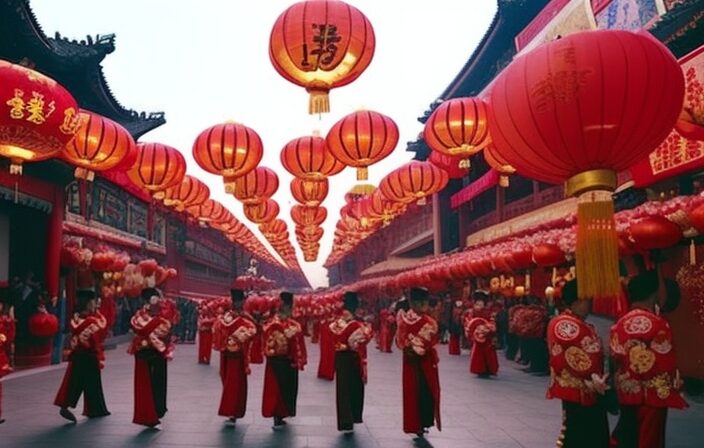The origins of the Chinese lunar calendar lie in early astronomical observations, the influence of Yin and Yang, and the contributions of ancient dynasties.
This calendar system has evolved over time through the development of the 24 solar terms and continues to be adapted in modern times for various celebrations.
In this article, we will explore the historical roots and cultural significance of this ancient calendrical tradition, providing a thorough and analytical examination of its evolution.
Key Takeaways
- Early astronomical observations were the foundation of the Chinese Lunar Calendar.
- The influence of Yin and Yang played a significant role in the development of the calendar.
- Ancient Chinese dynasties made important contributions to the calendar’s structure and refinement.
- The Chinese Lunar Calendar consists of ancient beginnings, lunar year structure, and the animal zodiac.
Early Astronomical Observations
Early astronomical observations played a crucial role in the development of the Chinese lunar calendar. The cultural significance of astronomy in ancient China cannot be overstated. Astronomical phenomena, such as lunar eclipses, were seen as celestial events with great symbolic importance. Ancient Chinese astronomers meticulously observed and recorded these events, using them to track time and establish a lunar-based calendar system.
Lunar eclipses were particularly significant in shaping the Chinese lunar calendar. These rare occurrences captured the attention of early observers who believed that they held deep cosmic meaning. They saw lunar eclipses as celestial omens, often associating them with political changes or natural disasters. Consequently, these observations prompted the establishment of methods to predict and calculate future occurrences.
By carefully studying lunar eclipses over centuries, Chinese astronomers developed an intricate understanding of their patterns and cycles. This knowledge enabled them to accurately forecast upcoming eclipses, providing valuable information for both religious ceremonies and agricultural planning.
Influence of Yin and Yang
The influence of Yin and Yang is a prominent factor in the development of the ancient system used for tracking celestial cycles. Yin and Yang are fundamental concepts in Chinese philosophy that represent opposing forces or energies, such as light and dark, hot and cold, and male and female. These concepts are not only applied to traditional medicine but also to various aspects of Chinese culture, including feng shui.
- Yin and Yang in traditional medicine: In traditional Chinese medicine, health is believed to be achieved through balancing the Yin and Yang energies within the body. The diagnosis and treatment of diseases are based on identifying imbalances between these two forces.
- Yin and Yang in feng shui: Feng shui is an ancient Chinese practice that aims to harmonize individuals with their environment by adjusting the flow of energy or Qi. The principles of Yin and Yang are applied when determining the placement of objects or structures to achieve balance between opposing energies.
- Incorporation into astrology: The concept of Yin-Yang is also incorporated into astrology practices related to divination, fortune-telling, or horoscope readings. It provides insights into an individual’s character traits, strengths, weaknesses, relationships, career choices based on their birth date.
- Application in agriculture: In agricultural practices influenced by Taoist principles like organic farming or biodynamic agriculture; farmers consider balancing yin-yang forces while planting specific crops during different seasons according to weather conditions for optimal growth.
Contributions of Ancient Dynasties
During the reign of the ancient dynasties, significant contributions were made to various fields such as astronomy, architecture, and governance. The influence of astrology played a crucial role in these contributions and had cultural significance in ancient China.
In terms of astronomy, the ancient Chinese dynasties developed sophisticated methods for observing celestial bodies and predicting astronomical events. This knowledge was used to create accurate calendars, which were essential for agricultural planning and religious ceremonies.
Additionally, the Chinese dynasties made remarkable architectural achievements by constructing grand palaces, temples, and tombs that showcased their power and artistic prowess. These structures not only served practical purposes but also held symbolic meanings within the culture.
Furthermore, governance during this period was characterized by a centralized system with strong emperors who implemented policies that shaped society’s values and norms. The rulers’ decisions were often influenced by astrological beliefs and divination practices that aimed to ensure good fortune and prosperity for their kingdoms.
Overall, the contributions of ancient Chinese dynasties in astronomy, architecture, and governance not only advanced their civilization but also left a lasting cultural legacy that continues to be celebrated today.
Development of the 24 Solar Terms
One notable aspect of the development of the 24 Solar Terms is their role in marking the seasonal changes and guiding agricultural activities. These terms have significant agricultural significance as they provide a framework for farmers to schedule and plan their planting, harvesting, and other farming activities. Additionally, the 24 Solar Terms also hold importance in traditional festivals celebrated across China.
- The 24 Solar Terms divide the year into 24 equal parts, with each term lasting around two weeks. This division allows farmers to align their agricultural activities with the specific characteristics of each season.
- Each Solar Term represents a distinct phase in nature’s cyclical patterns, such as the beginning of spring or summer solstice. By following these terms, farmers can determine when to sow seeds, transplant seedlings, apply fertilizers or pesticides, and harvest crops.
- The alignment between the 24 Solar Terms and traditional festivals is not coincidental. Many traditional Chinese festivals are closely tied to agricultural practices and natural phenomena associated with specific Solar Terms.
- For example, Qingming Festival (Tomb-sweeping Day) falls on the day of ‘Qingming,’ which signifies a transition from cold winter to mild spring weather. During this festival, people visit ancestral graves and enjoy outdoor activities that symbolize embracing new life after winter’s end.
Overall, the development of the 24 Solar Terms has played a crucial role in marking seasonal changes for agricultural purposes while also influencing traditional festivities deeply rooted in China’s agrarian heritage.
Modern Adaptations and Celebrations
Modern adaptations and celebrations of the 24 Solar Terms include incorporating them into contemporary agricultural practices and organizing public events to raise awareness about traditional Chinese cultural heritage. These modern customs highlight the cultural significance of the Solar Terms in China today.
In terms of agriculture, farmers use the 24 Solar Terms as a guide for their planting, harvesting, and other farming activities. By aligning their practices with these solar-based divisions of time, they aim to maximize crop yields and ensure optimal growing conditions. For example, during the Grain Rain period, which marks the transition from spring to summer, farmers focus on sowing crops like rice and corn. Similarly, during Minor Snow, they prepare for winter by storing food supplies and protecting livestock.
Furthermore, public events are organized throughout China to celebrate the 24 Solar Terms and promote traditional Chinese culture. These events often feature exhibitions that showcase ancient writings on the Solar Terms or display artwork inspired by them. Additionally, workshops are conducted where participants can learn about traditional customs associated with each term.
Through these modern adaptations and celebrations, the 24 Solar Terms continue to hold cultural significance in China today by connecting people with their agricultural heritage and fostering a deeper appreciation for the country’s rich traditions.
Conclusion
The Chinese lunar calendar has a rich history that can be traced back to early astronomical observations. The influence of Yin and Yang in Chinese culture played a significant role in the development of this calendar.
Various ancient dynasties made important contributions to its evolution, incorporating celestial events into their political and religious practices. The 24 solar terms further refined the calendar, marking important agricultural and seasonal changes.
Today, the Chinese lunar calendar continues to be adapted and celebrated worldwide. How has this ancient system stood the test of time?



